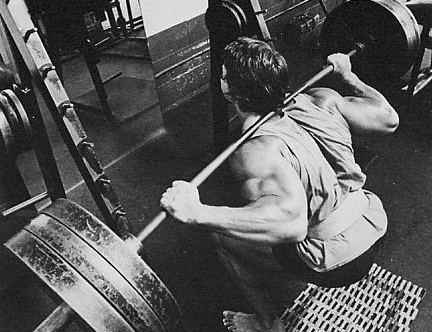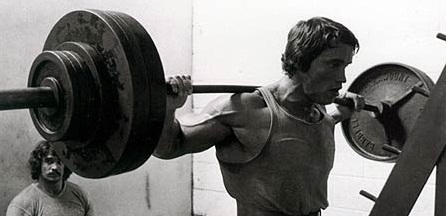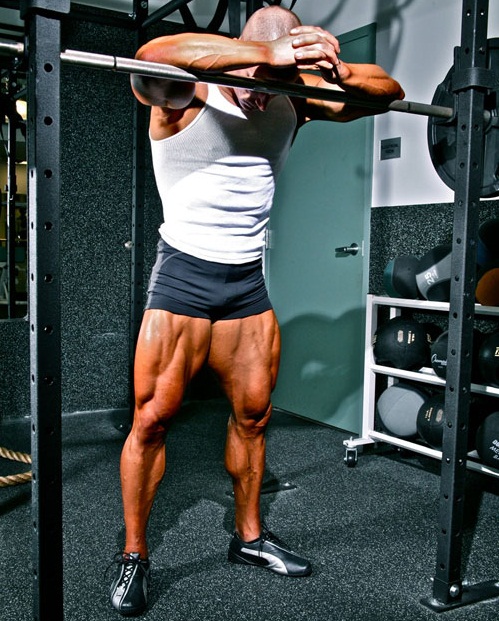Legs the size of Mini Coopers. If you’re avoiding the squat rack, it’s time to give that daydream a rest. The squat is one of the most revered choices in the exercise catalog because of its uncanny ability to pack muscle onto your wheels. Bodybuilding greats (and squat scholars) eight-time Mr. Olympia Ronnie Coleman and two-time Arnold Classic winner Kevin Levrone both swore by it as the lower-body mass-building movement.
In theory, it’s as primal as using a bone for a toothbrush you drape a bar loaded with weight on your back, crouch down and explode up. Easier said than done. Executing the squat properly is anything but basic. Jim Stoppani, PhD, provides a step-by-step guide, plus tips so you’ll know squat about the squat.

Get To Know Squat
Now that you’ve been schooled in the squat, follow these tips from Stoppani to ensure that you’re packing bulk onto your lower limbs.
1 Find Your Footing
Positioning your feet wide, like a sumo squat, will target the glutes and inner quads. A narrow stance will focus on the outer area of the legs and develop more quad sweep.
2 Head In The Game
Never look down, because glancing downward will flex your cervical spine and put pressure on the disks in your neck.
3 Watch Your Weight
Do not trade form for weight. A bunch of plates jammed onto the bar might boost your ego, but it won’t improve your legs. Go lighter and perfect the mechanics until your form is sound.
4 How Low Should You Go?
Descend until your upper legs are parallel to the ground. Stopping short of that position can detract from full upper-leg development.
5 Ramp Up The Reps
Consistency with reps could shortchange growth. The majority should fall in the 8-12 range, the legs respond well to higher reps, but don’t hesitate to ramp it up to 15 reps if you feel inclined.
6 Rest Remix
Two to three minutes between sets should be plenty of time to recover. But, just as you do with reps, mix it up. Shorter rest periods of a minute or 30 seconds will exhaust the muscle, allow for a larger build up of lactic acid and cause the body to release more growth hormone.
7 Wrap It Up
In the past, it was widely believed that knee wraps prohibited muscle activity, because of the reliance on the wraps’ elasticity. A new study from Armstrong Atlantic State University in Savannah, Georgia, shows that wraps do not interfere with muscle growth and may even allow you to go heavier.
8 Belt One Out
Use a weight belt when squatting up to or exceeding 80% of your one-rep max. An added benefit of a belt: it can further increase pressure in the abdominal cavity for better stabilization of the spine.
9 Knees And Toes
You’ve heard it before: extending your knees over your toes will cause injury. Not necessarily. A new study shows that trying to prevent this actually placed more stress on the lower back, and that the knees experienced less stress when they did extend past the toes.
10 Partial Squats
Develop bigger teardrop muscles by performing only the upper half of the movement with heavier weight as this is when the muscle receives most of the stress. Do two or three sets of these before moving on to full squats.
Primary Muscles Worked
- Quadriceps
- Hamstrings
- Glutes
- Adductors
- Sartorius
Secondary Muscles Worked
- Calves
- Spinal erectors
- Abdominals

Mad Squat
Here’s how to safely test your 1RM on the squat.
- When attempting your 1RM, make sure to grab a strong spotter (or two). If you get into a jam with a ton of weight on your back, you’ll be happy for the extra hands.
- If you’re going at it solo which isn’t recommended use a power rack and set the safety bars just below the bottom position of your squat so it can catch the bar if you fail on your attempt.
Take as many warm-up sets as you need.
Complete no more than six reps for the first two sets, then drop to one or two reps as you gradually increase the weight toward your 1RM attempt. Remember, you’re trying to get loose, not push your muscles to failure.
Now you’re warmed up and it’s time to find your max.
Choose a weight you can lift for 6-10 reps to failure. Now add 30%-40% more weight. Attempt no more than one rep. If you completed the rep, rest 3-4 minutes and add 5-10 pounds. If you didn’t, remove 5-10 pounds and go at it again after resting 3-4 minutes.
The final weight you successfully complete once is your true 1RM.
- The bar should rest near your midtraps and rear delts (rather than your upper traps). This will make it easier to balance the weight throughout the exercise.
- Keep your head aligned with your spine by fixing your gaze on an object at eye level. This will help maintain balance.
- Grasping the bar with your thumbs wrapped around the bar, bring your hands as close to your shoulders as possible and press the bar against your back. Squeezing your shoulder blades together and pulling your elbows forward will help you support the bar.
- Place your feet just beyond shoulder width; this positioning may vary slightly depending on your flexibility and comfort.
- Maintain the arch in your lower back and push your chest up and out. Contract your spinal erector muscles and abdominals to keep your core tight.
- Keep a slight bend in your knees and contract your quads, hamstrings and glutes. Take a deep breath and hold it as you begin your descent. This will support the spine by increasing pressure inside the abdominal and chest cavities.
- Stick your glutes out as if sitting down in a chair. Descend until your upper legs are parallel to the floor.
- Begin the ascent by driving through your heels. Imagine pushing the floor away as you thrust upward with your legs. Keep your heels on the floor to avoid leaning forward.
- Concentrate on moving your hips before extending your knees. Keep your hips under the bar as much as possible to avoid leaning forward. This will relieve stress on your lower back.
- As you ascend, force your knees out hard and push out on the sides of your shoes. This will help keep tension in your hips for greater strength.
- Exhale as you pass the most difficult phase of the squat.
- Without lifting your chin, push your head back to help contract your traps for greater stability.

Our Tip: Grab A Spot
You don’t want to risk damaging equipment or injuring the people around you, so ask for a spot from someone who is strong enough to get you out of trouble when you’ve squatting heavy. If a massive amount of weight crushes your spine, you’re out of the gym as well as out of commission for a long time.
Not comfortable attempting a 1RM?
Not a problem. Take a weight with which you can squat for 10 reps, the 10th being the absolute last you can complete. Multiply that weight by 1.33. That will give you your estimated 1RM.
Example:
You squatted 300 pounds for 10 reps: 300 x 1.33 = 399 pounds Round up (400 pounds)
Squat By The Numbers
1,250
- Pounds squatted by all-time squat world record holder Vlad Alhazov in 2008
15-20
- Percentage of strength lost when moving from a shoulder-width stance to a hip-width stance
50
- Percent increase in calories burned when performing the squat compared to the leg press
10-15
- Percent increase in strength when using a weightlifting belt and knee wraps while squatting
405
- Pounds squatted by Derik Farnsworth for 30 reps in 2008 (he weighed 188 pounds)
23
- Number of reps Tom Platz squatted with 495 pounds in 1992
Author: Jim Stoppani, PhD
References:
http://www.muscleandfitness.com/
http://www.flexonline.com/
COPYRIGHT 2011 Weider Publications
COPYRIGHT 2011 Gale Group










